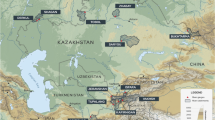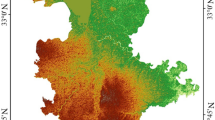Abstract
Rivers receive a large amount of pollution due to the wide concentration of human activities. This study investigated the effects of climate change on the Dez river water quality and the application of an improvement scenario to improve the Dez river's water quality. The QUAL2kw model was used to simulate water quality parameters. Comparison of error indices for the model in the calibration and validation period with acceptable error values shows that the QUAL2Kw model has acceptable accuracy for simulating temperature and water quality. Furthermore, by applying the point pollutant load reduction scenario, it was found that the quality parameters of the river water can be controlled to a large extent. In addition, after water quality simulation, the effects of climate change in the future (2031–2060) were investigated using the climate scenarios from the sixth assessment report, which presents a new group of emission scenarios called SSP scenarios. Two scenarios, SSP1 and SSP5, were considered in this study. The results of the MPI-ESM1-2-HR climate model showed an increase in annual temperature and a decrease in precipitation in both scenarios for the coming years. The maximum temperature in the SSP1 and SSP5 scenarios increased by + 0.87% and + 1.53%, respectively, and the precipitation showed a decrease of − 0.35% and − 8.34%, respectively. According to the results obtained from water quality prediction under climate change scenarios for the coming period, BOD and COD parameters have exceeded their standard limits for drinking purposes.










Similar content being viewed by others
Availability of data and materials
The data that support the findings of this study are available from the corresponding author upon reasonable request.
References
Alleman JE (2000) The history of fixed-film wastewater treatment systems. Article-biofilmhistory. https://home.engineering.iastate.edu/~jea/w3-class/456/article/article-biofilmhistory.html. Accessed 15 May 2022
Areeyaenezhad R, Sarai Tabrizi M, Babazadeh H (2019) Modeling water quality of rivers using QUAL2Kw model (case study: Shahroud River). J Environ Sci Technol 21(7):1–13. https://doi.org/10.22034/jest.2018.30267.3894
Astaraie-Imani M, Kapelan Z, Fu G, Butler D (2012) Assessing the combined effects of urbanisation and climate change on the river water quality in an integrated urban wastewater system in the UK. J Environ Manag 112:1–9. https://doi.org/10.1016/j.jenvman.2012.06.039
Bates B, Kundzewicz ZW, Wu S, Burkett V, Doell P, Gwary D, Hanson C, Heij B, Jiménez B, Kaser G, Kitoh A, Kovats S, Kumar P, Magadza CHD, Martino D, Mata L, Medany M, Miller K, Arnell N (2008) Climate change and water. Technical paper of the intergovernmental panel on climate change. https://www.ipcc.ch/publication/climate-change-and-water-2/. Accessed 10 July 2022
Bowie GL, Laboratory ER, Tech T (1985) Rates, constants, and kinetics formulations in surface water quality modeling, Environmental Research Laboratory, Office of Research and Development, U.S. Environmental Protection Agency
Chang H (2008) Spatial analysis of water quality trends in the Han River Basin, South Korea. Water Res 42:3285–3304. https://doi.org/10.1016/j.watres.2008.04.006
Chapra SC, Pelletier GJ, Tao H (2008) QUAL2K: a Modeling framework for simulating river and stream water quality, version 2.11. USA: documentation and user’s manual. Civil and Environmental Engineering Department, Tufts University, Medford
Chapra SCAP, GJ (2003) QUAL2K: a modeling framework for simulating river and stream water quality: documentation and users manual
Charbonneau P, Knapp B (1995) A user's guide to PIKAIA 1.0
Das Kangabam R, Govindaraju M (2019) Anthropogenic activity-induced water quality degradation in the Loktak lake, a Ramsar site in the Indo-Burma biodiversity hotspot. Environ Technol 40(17):2232–2241. https://doi.org/10.1080/09593330.2017.1378267
Fatehifar A, Goodarzi MR, Montazeri Hedesh SS, Siahvashi Dastjerdi P (2021) Assessing watershed hydrological response to climate change based on signature indices. J Water Clim Change 12(6):2579–2593. https://doi.org/10.2166/wcc.2021.293
Goodarzi MR, Fatehifar A, Moradi A (2020) Predicting future flood frequency under climate change using copula function. Water Environ J 34(S1):710–727. https://doi.org/10.1111/wej.12572
Goodarzi MR, Niknam ARR, Jamali V, Pourghasemi HR (2022) Aquifer vulnerability identification using DRASTIC-LU model modification by fuzzy analytic hierarchy process. Model Earth Syst Environ 8(4):5365–5380. https://doi.org/10.1007/s40808-022-01408-4
Gupta V, Singh V, Jain MK (2020) Assessment of precipitation extremes in India during the 21st century under SSP1–1.9 mitigation scenarios of CMIP6 GCMs. J Hydrol 590:125422. https://doi.org/10.1016/j.jhydrol.2020.125422
Iran Standard and Industrial Research Institute (ISIRI) (2010) Drinking water—National Standard No. 1053, physical and chemical characteristics, 5th edn
Ismail A, Robescu LD (2017) Application of a one-dimensional steady state model for simulation the water quality in a large river: a case study of the Danube river. UPB Sci Bull Ser D Mech Eng 79:183–192
Kannel PR, Lee S, Kanel SR, Lee Y-S, Ahn K-H (2007) Application of QUAL2Kw for water quality modeling and dissolved oxygen control in the river Bagmati. Environ Monit Assess 125(1):201–217. https://doi.org/10.1007/s10661-006-9255-0
Kükrer S, Mutlu E (2019) Assessment of surface water quality using water quality index and multivariate statistical analyses in Saraydüzü Dam Lake, Turkey. Environ Monit Assess. https://doi.org/10.1007/s10661-019-7197-6
Lai Y, Dzombak DA (2021) Assessing the effect of changing ambient air temperature on water temperature and quality in drinking water distribution systems. Water 13(14):1916
Liang-Liang L, Jian L, Ru-Cong Y (2022) Evaluation of CMIP6 HighResMIP models in simulating precipitation over Central Asia. Adv Clim Change Res 13(1):1–13. https://doi.org/10.1016/j.accre.2021.09.009
Moriasi DN, Arnold JG, Liew M, Bingner RL, Harmel RD, Veith TL (2007) Model evaluation guidelines for systematic quantification of accuracy in watershed simulations. Trans ASABE 50:885–900. https://doi.org/10.13031/2013.23153
Morrill JC, Bales RC, Conklin MH (2001) The relationship between air temperature and stream temperature. In AGU Spring Meeting Abstracts, H42A09. https://ui.adsabs.harvard.edu/abs/2001AGUSM...H42A09M. Accessed 26 Sept 2022
Nazarenko LS, Tausnev N, Russell GL, Rind D, Miller RL, Schmidt GA, Bauer SE, Kelley M, Ruedy R, Ackerman AS, Aleinov I, Bauer M, Bleck R, Canuto V, Cesana G, Cheng Y, Clune TL, Cook BI, Cruz CA, Del Genio AD, Elsaesser GS, Faluvegi G, Kiang NY, Kim D, Lacis AA, Leboissetier A, LeGrande AN, Lo KK, Marshall J, Matthews EE, McDermid S, Mezuman K, Murray LT, Oinas V, Orbe C, García-Pando CP, Perlwitz JP, Puma MJ, Romanou A, Shindell DT, Sun S, Tsigaridis K, Tselioudis G, Weng E, Wu J, Yao M-S (2022) Future climate change under SSP emission scenarios with GISS-E2.1. J Adv Model Earth Syst 14(7):e2021MS002871. https://doi.org/10.1029/2021MS002871
Nikakhtar M, Rahmati SH, Bavani ARM (2019) Impact of climate change on the future quality of surface waters: case study of the Ardak River, northeast of Iran. J Water Clim Change 11(3):685–702. https://doi.org/10.2166/wcc.2019.132
Organization WH (2017) Guidelines for drinking-water quality: fourth edition incorporating the first addendum, World Health Organization Copyright © World Health Organization 2017, Geneva
Paliwal R, Sharma P, Kansal A (2007) Water quality modelling of the river Yamuna (India) using QUAL2E-UNCAS. J Environ Manag 83(2):131–144. https://doi.org/10.1016/j.jenvman.2006.02.003
Pelletier GJ, Chapra SC, Tao H (2006) QUAL2Kw—a framework for modeling water quality in streams and rivers using a genetic algorithm for calibration. Environ Model Softw 21(3):419–425
Raeisi N, Moradi S, Scholz M (2022) Surface water resources assessment and planning with the QUAL2KW model: a case study of the Maroon and Jarahi Basin (Iran). Water 14(5):705. https://doi.org/10.3390/w14050705
Rafiee M, Akhond Ali AM, Moazed H, Lyon SW, Jaafarzadeh N, Zahraie B (2014) A case study of water quality modeling of the Gargar River, Iran. J Hydraul Struct 1(2):10–22. https://doi.org/10.22055/JHS.2014.10533
Rehana S, Mujumdar PP (2011) River water quality response under hypothetical climate change scenarios in Tunga-Bhadra river, India. Hydrol Process 25(22):3373–3386. https://doi.org/10.1002/hyp.8057
Riahi K, van Vuuren DP, Kriegler E, Edmonds J, O’Neill BC, Fujimori S, Bauer N, Calvin K, Dellink R, Fricko O, Lutz W, Popp A, Cuaresma JC, Kc S, Leimbach M, Jiang L, Kram T, Rao S, Emmerling J, Ebi K, Hasegawa T, Havlik P, Humpenöder F, Da Silva LA, Smith S, Stehfest E, Bosetti V, Eom J, Gernaat D, Masui T, Rogelj J, Strefler J, Drouet L, Krey V, Luderer G, Harmsen M, Takahashi K, Baumstark L, Doelman JC, Kainuma M, Klimont Z, Marangoni G, Lotze-Campen H, Obersteiner M, Tabeau A, Tavoni M (2017) The shared socioeconomic pathways and their energy, land use, and greenhouse gas emissions implications: an overview. Glob Environ Change 42:153–168. https://doi.org/10.1016/j.gloenvcha.2016.05.009
Santos S, Vilar VJP, Alves P, Boaventura RAR, Botelho C (2013) Water quality in Minho/Miño River (Portugal/Spain). Environ Monit Assess 185(4):3269–3281. https://doi.org/10.1007/s10661-012-2789-4
Sharma D, Kansal A, Pelletier G (2017) Water quality modeling for urban reach of Yamuna river, India (1999–2009), using QUAL2Kw. Appl Water Sci 7(3):1535–1559. https://doi.org/10.1007/s13201-015-0311-1
Su B, Huang J, Mondal SK, Zhai J, Wang Y, Wen S, Gao M, Lv Y, Jiang S, Jiang T, Li A (2021) Insight from CMIP6 SSP-RCP scenarios for future drought characteristics in China. Atmos Res 250:105375. https://doi.org/10.1016/j.atmosres.2020.105375
Suryawan IWK, Prajati G, Afifah AS, Apritama MR (2021) NH3-N and COD reduction in Endek (balinese textile) wastewater by activated sludge under different DO condition with ozone pretreatment. Walailak J Sci Technol 18(6):9127. https://doi.org/10.48048/wjst.2021.9127
USEPA (2003) Human health toxicity values in superfund risk assessments. OSWER Directive 9285:753
Vieira J, Fonseca A, Vilar VJP, Boaventura RAR, Botelho CMS (2013) Water quality modelling of Lis River, Portugal. Environ Sci Pollut Res 20(1):508–524. https://doi.org/10.1007/s11356-012-1124-5
Wilby RL, Dawson CW (2013) The Statistical DownScaling Model: insights from one decade of application. Int J Climatol 33(7):1707–1719. https://doi.org/10.1002/joc.3544
Zhu W, Niu Q, Zhang R, Ye R, Qian X, Qian Y (2015) Application of QUAL2K model to assess ecological purification technology for a polluted river. Int J Environ Res Public Health 12(2):2215–2229. https://doi.org/10.3390/ijerph120202215
Funding
The authors declare that no funds, grants, or other support were received during the preparation of this manuscript.
Author information
Authors and Affiliations
Contributions
All authors contributed to the study conception and design. Material preparation, data collection were performed by MRG, ARRN, SHR. In addition, analysis and modeling were performed by all authors. The first draft of the manuscript was written by ARRN and AF and all authors commented on previous versions of the manuscript. All authors read and approved the final manuscript.
Corresponding author
Ethics declarations
Conflict of interest
The authors have no relevant financial or non-financial interests to disclose.
Additional information
Publisher's Note
Springer Nature remains neutral with regard to jurisdictional claims in published maps and institutional affiliations.
Rights and permissions
Springer Nature or its licensor (e.g. a society or other partner) holds exclusive rights to this article under a publishing agreement with the author(s) or other rightsholder(s); author self-archiving of the accepted manuscript version of this article is solely governed by the terms of such publishing agreement and applicable law.
About this article
Cite this article
Goodarzi, M.R., Niknam, A.R.R., Rahmati, S.H. et al. Evaluation of the effects of climate change and pollution discharge scenario on the quality of Dez River using the QUAL2Kw model. Environ Earth Sci 82, 479 (2023). https://doi.org/10.1007/s12665-023-11175-9
Received:
Accepted:
Published:
DOI: https://doi.org/10.1007/s12665-023-11175-9




